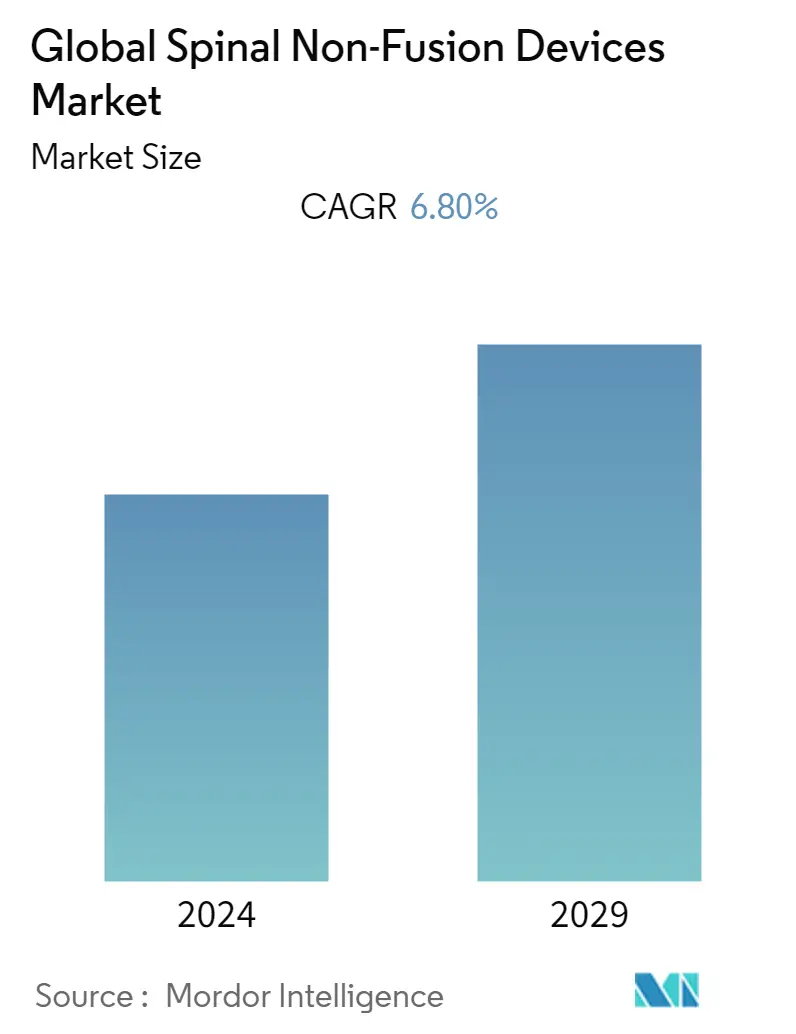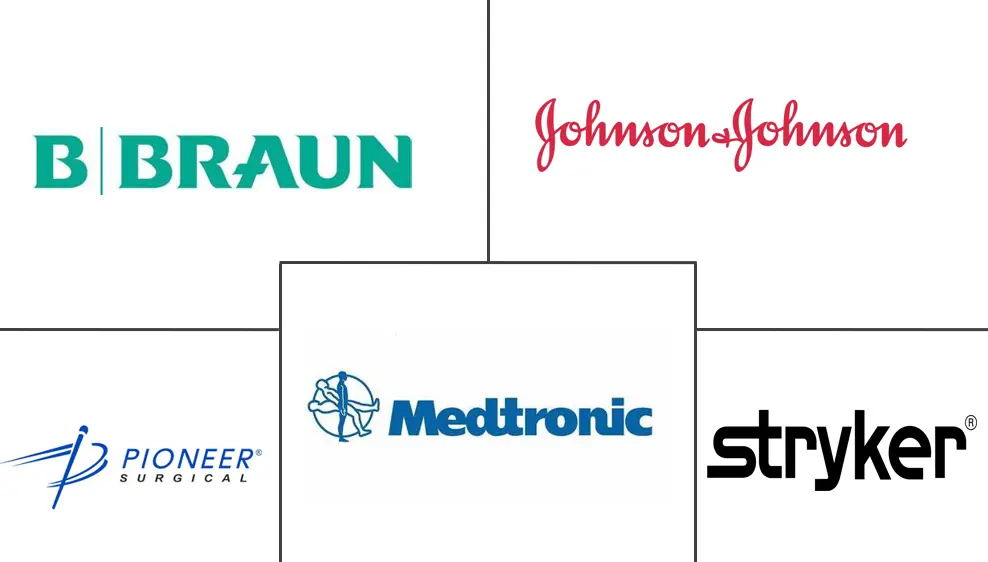Market Size of Global Spinal Non-Fusion Devices Industry

| Study Period | 2019 - 2029 |
| Base Year For Estimation | 2023 |
| CAGR | 6.80 % |
| Fastest Growing Market | Asia Pacific |
| Largest Market | North America |
| Market Concentration | Medium |
Major Players
*Disclaimer: Major Players sorted in no particular order |
Spinal Non-Fusion Devices Market Analysis
The spinal non-fusion devices market is expected to register a CAGR of 6.8% over the forecast period.
The COVID-19 pandemic has significantly impacted the spinal non-fusion devices market worldwide. In addition to the effects of the disease on public health, there was also a collateral effect on the disruption and cancelation of surgical services. For instance, a research study titled "COVID-19 pandemic and elective spinal surgery cancelations - what happens to the patients?" published in PubMed, in December 2021, stated that due to the reallocation of resources to the care of COVID-19 patients, the COVID-19 pandemic resulted in a suspension of elective procedures. Following the start of elective surgeries, a considerable number of patients continued to postpone surgery, with many still waiting to be rescheduled, potentially prolonging their discomfort and impairment of function. The study concluded that over one-third of the elective spine procedures that were canceled due to COVID-19 had not been performed in the eight months since the procedures were resumed. Such instances had adverse impact on the demand for spinal surgery devices over the pandemic phase.
Furthermore, the CovidSurg Collaborative, a 120-country research initiative formed to analyze the impact of the COVID-19 pandemic on surgeries, predicted that approximately 28.4 million elective surgeries were canceled or postponed in 2020. Thus, impacting the demand for spinal surgery devices worldwide. Likewise, as per an article published in 2021 under the title, "The Impact of the COVID-19 Pandemic on Spine Surgery in Central Europe: A Questionnaire-Based Study", the COVID-19 pandemic resulted in comparable restrictive measures for spinal surgical departments in Central Europe. As per the same source, elective surgical interventions were reduced. Such incidences have reduced the use of spinal surgery devices owing to the lower number of surgeries performed. However, the market is expected to gain traction over the coming years as a result of declining COVID-19 cases and the resumption of elective surgeries.
Further, the key factors propelling the growth of this market are the increasing adoption rate of minimally invasive spinal surgeries, an upsurge in technological advancements in the spinal surgery sector, and growing incidences of obesity and degenerative spinal conditions. The companies are also engaged in the development of innovative products which is further supporting the market growth. For instance, in June 2021, a team of engineers and clinicians at the University of Cambridge developed an ultra-thin, inflatable spinal device that can be used to treat the most severe forms of pain without the need for invasive surgery. Moreover, in July 2021, NuVasive's Pulse platform for spine surgery received United States Food and Drugs Administration (US FDA) 510 (k) approval. Such developments are fueling the adoption and demand for spinal surgery devices, thereby contributing to the market's growth.
Furthermore, the increasing prevalence of obesity is also contributing to the market growth. For instance, as per the June 2021 statistics by the World Health Organization (WHO), 39 million children under the age of 5 were overweight or obese in 2020. As the obese population with a higher Body Mass Index (BMI) was more vulnerable to spine-related disorders and back pain, the demand for spinal surgeries among this age group is likely to increase soon, ultimately driving the growth of the spinal surgery devices market.
However, the stringent regulatory process for new product approvals and expensive treatment and procedures are the major factors that restrain the market's growth.
Spinal Non-Fusion Devices Industry Segmentation
As per the scope of the report, spinal non-fusion devices are medical devices that are employed in the correction of anatomical surgical defects of the spine using a non-fusion approach. Spinal non-fusion devices are used by surgeons during surgery for the treatment of deformity, stabilization, and strengthening of the spine and for promoting fusion. The Spinal Non-Fusion Devices Market is segmented by Product (Artificial Disc Replacement, Dynamic Stabilization Devices, Annulus Repair Devices, Nuclear Disc Prostheses, and Other Products), End User (Hospitals, Orthopedic Centers, and Other End Users), and Geography (North America, Europe, Asia-Pacific, Middle East and Africa, and South America). The market report also covers the estimated market sizes and trends for 17 different countries across major regions, globally. The report offers the value (in USD million) for the above segments.
| By Product | |
| Artificial Discs Replacement | |
| Dynamic Stabilization Devices | |
| Annulus Repair Devices | |
| Nuclear Disc Prostheses | |
| Other Products |
| By End User | |
| Hospitals | |
| Orthopedic Centers | |
| Other End Users |
| Geography | ||||||||
| ||||||||
| ||||||||
| ||||||||
| ||||||||
|
Global Spinal Non-Fusion Devices Market Size Summary
The spinal non-fusion devices market is poised for significant growth, driven by the increasing adoption of minimally invasive spinal surgeries and technological advancements in the field. The market experienced disruptions during the COVID-19 pandemic, which led to the cancellation and postponement of elective surgeries, adversely affecting the demand for spinal surgery devices. However, as elective surgeries resume and COVID-19 cases decline, the market is expected to regain momentum. Key factors such as the rising prevalence of obesity and degenerative spinal conditions, along with innovative product developments, are further propelling market growth. Notable advancements include the development of ultra-thin, inflatable spinal devices and the approval of advanced surgical platforms, which are enhancing the adoption and demand for spinal surgery devices.
In North America, particularly the United States, the market is dominated by the increasing number of individuals suffering from spine-related disorders and the growing preference for minimally invasive procedures. The dynamic stabilization devices segment holds a significant market share, supported by technological advancements and the need for non-fusion solutions to treat lumbar degenerative diseases. Despite challenges such as stringent regulatory processes and high treatment costs, the market is characterized by intense competition among major players like Medtronic, Stryker Corporation, and NuVasive Inc. These companies are actively engaging in strategic initiatives, including mergers and acquisitions, to enhance their market position and drive innovation in spinal non-fusion devices.
Global Spinal Non-Fusion Devices Market Size - Table of Contents
-
1. MARKET DYNAMICS
-
1.1 Market Overview
-
1.2 Market Drivers
-
1.2.1 Increasing Cases of Degenerative Disc Disease (DDD)
-
1.2.2 Acceptance of Minimally Invasive Surgeries such as Disc Arthroscopy
-
1.2.3 Advantages over Spinal Fusion Surgeries
-
-
1.3 Market Restraints
-
1.3.1 Reimbursement Challenges
-
1.3.2 Availability of Alternatives
-
-
1.4 Porter's Five Forces Analysis
-
1.4.1 Threat of New Entrants
-
1.4.2 Bargaining Power of Buyers/Consumers
-
1.4.3 Bargaining Power of Suppliers
-
1.4.4 Threat of Substitute Products
-
1.4.5 Intensity of Competitive Rivalry
-
-
-
2. MARKET SEGMENTATION (Market Size by Value - USD million)
-
2.1 By Product
-
2.1.1 Artificial Discs Replacement
-
2.1.2 Dynamic Stabilization Devices
-
2.1.3 Annulus Repair Devices
-
2.1.4 Nuclear Disc Prostheses
-
2.1.5 Other Products
-
-
2.2 By End User
-
2.2.1 Hospitals
-
2.2.2 Orthopedic Centers
-
2.2.3 Other End Users
-
-
2.3 Geography
-
2.3.1 North America
-
2.3.1.1 United States
-
2.3.1.2 Canada
-
2.3.1.3 Mexico
-
-
2.3.2 Europe
-
2.3.2.1 United Kingdom
-
2.3.2.2 Germany
-
2.3.2.3 France
-
2.3.2.4 Italy
-
2.3.2.5 Spain
-
2.3.2.6 Rest of Europe
-
-
2.3.3 Asia-Pacific
-
2.3.3.1 China
-
2.3.3.2 Japan
-
2.3.3.3 India
-
2.3.3.4 Australia
-
2.3.3.5 South Korea
-
2.3.3.6 Rest of Asia-Pacific
-
-
2.3.4 Middle-East and Africa
-
2.3.4.1 GCC
-
2.3.4.2 South Africa
-
2.3.4.3 Rest of Middle-East and Africa
-
-
2.3.5 South America
-
2.3.5.1 Brazil
-
2.3.5.2 Argentina
-
2.3.5.3 Rest of South America
-
-
-
Global Spinal Non-Fusion Devices Market Size FAQs
What is the current Global Spinal Non-Fusion Devices Market size?
The Global Spinal Non-Fusion Devices Market is projected to register a CAGR of 6.80% during the forecast period (2024-2029)
Who are the key players in Global Spinal Non-Fusion Devices Market?
Stryker Corporation, Zimmer Holdings Inc., Johnson & Johnson, Medtronic PLC and B Braun Melsungen are the major companies operating in the Global Spinal Non-Fusion Devices Market.

